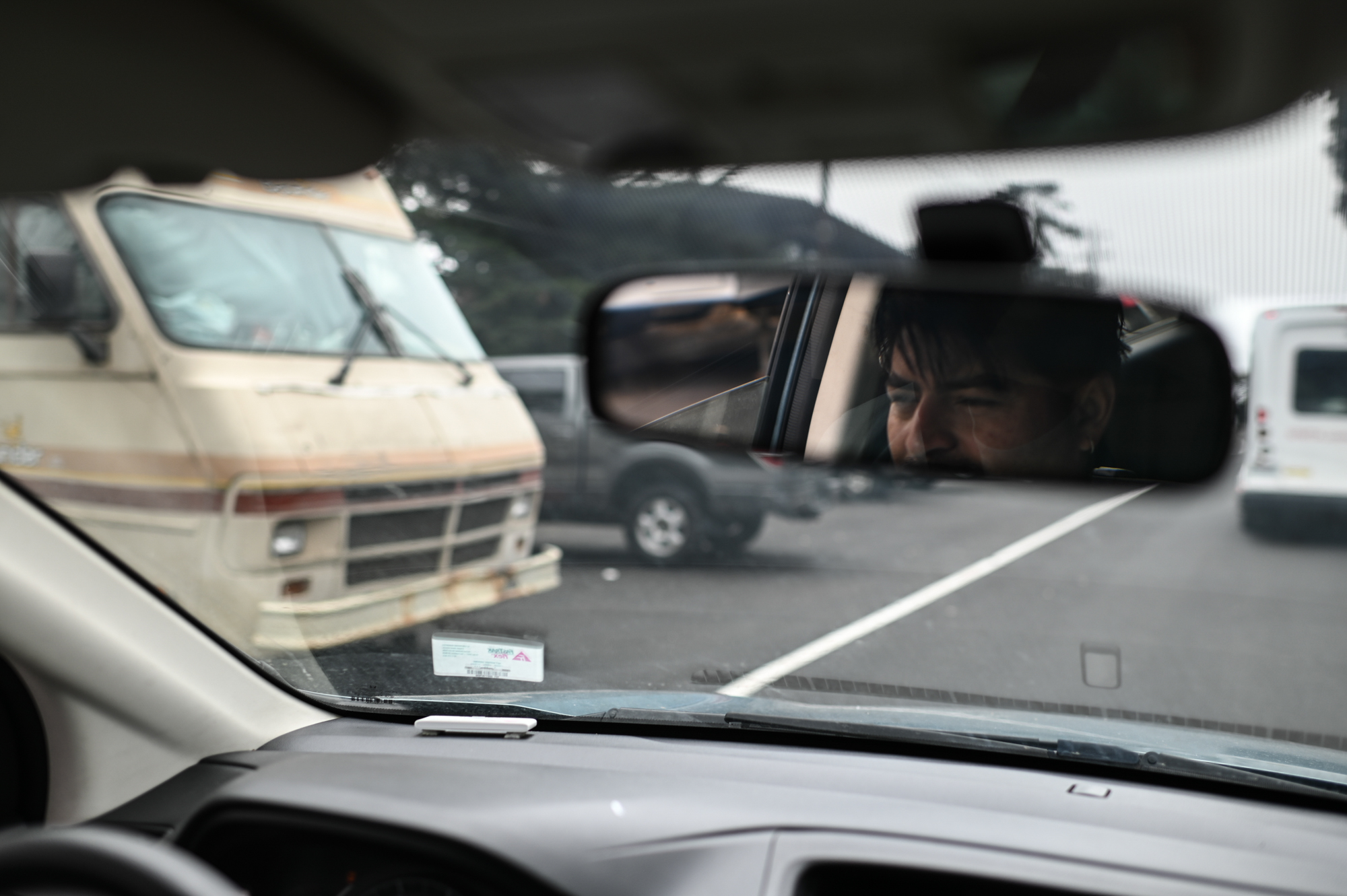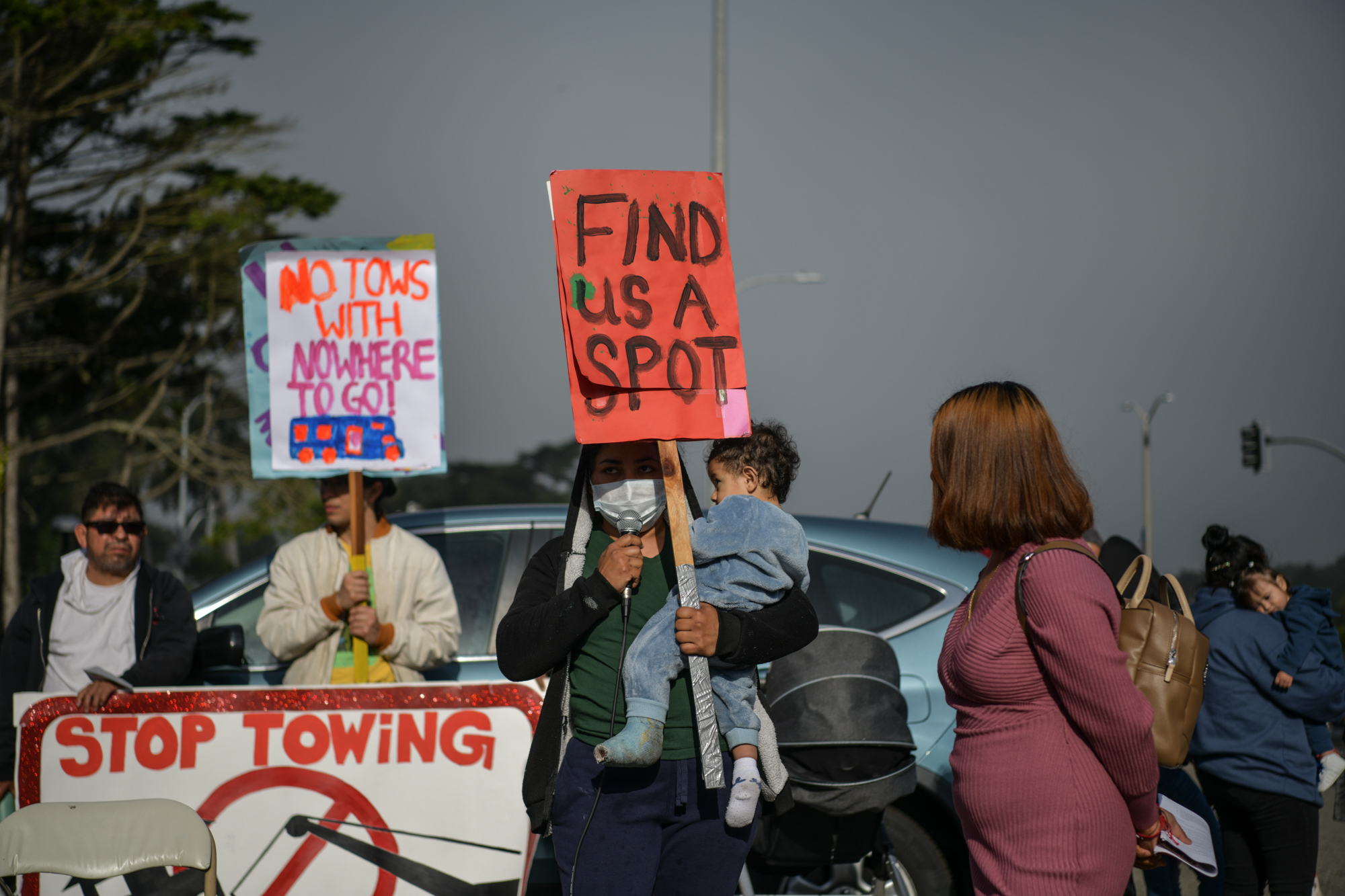“Bear in mind that this enforcement will not result in towing,” SFMTA liaison Joél Ramos wrote in a July 2024 email. “It is the Supervisor’s hope that the threat and/or issuance of parking citations alone will result in people moving the RVs.”
When tickets didn’t work, officials used a street repaving project to clear RVs, citing safety and logistics. The project became a public-facing justification that masked what internal emails described as political urgency.
The strategy worked. Families were pushed out. The press framed the evictions as development-driven.
Three days before the city’s July 2024 deadline to clear Winston Drive, more than 20 RVs caravanned to an empty private lot near the San Francisco Zoo in an attempt to pressure the city to provide an alternative safe parking site. That same night, police and park rangers redirected them to Zoo Road, near the Pomeroy Center.
That same strategy — combining parking restrictions and construction — was quickly replicated on Zoo Road.
SFMTA began enforcing the 72-hour parking rule. But internal emails questioned its use.
“The purpose of [the] 72-hour rule is to ensure vehicles are not abandoned,” wrote SFMTA’s Chadwick Lee. “I do not believe it’s applicable in this case.”
Director of Parking Enforcement Scott Edwards said in another email: “If a vehicle moves an inch, then it cannot be cited or towed.”
To work around this limitation, SFMTA signed a work order for curb painting and restriping on Zoo Road, using the same contract from Winston. Advocates questioned whether the work was even necessary.
“Families who did not qualify for housing who were promised safe parking for 3 years by [the] city are being evicted again,” read a Coalition on Homelessness Instagram post. “We spoke to workers who confirmed the [restriping] work has been completed so why exactly does the city require them to move?”
3. Evictions resulted in predictable consequences
Even before enforcement began, internal emails flagged likely fallout: displaced families would scatter across the city.
As early as March 2023, SFMTA policy manager Hank Wilson flagged in an email to Melgar’s office the likely fallout: “as we all know, the proposed 4-hour time limits would impact the large number of vehicles (120 or so).” He added that “It likely will push those folks living in vehicles to other blocks in the City.”
That’s exactly what happened. As RVs were cleared from Winston and Zoo Road, they appeared on John Muir Drive, Vidal, 19th Avenue, the Bayview neighborhood, and beyond. Neighbors complained. Supervisors called for new restrictions.
“As many predicted, displacing these vehicles from Winston Drive has merely moved the problem to other areas,” wrote an anonymous constituent to District 4 Supervisor Joe Engardio on Aug. 9, 2024. “Each day more and more RVs, vans, trailers, and trucks are showing up in front of Rolph Nicol Park and around the Merced Manor Reservoir.”
“We obviously need a bigger citywide plan and process,” wrote Thornley on Aug. 21, responding to a complaint on Phelps Street. “Or we’ll just keep pushing large vehicles around from neighborhood to neighborhood — not good for anyone.”

4. Winston became the city’s de-facto eviction playbook
After Winston and Zoo Road, SFMTA began using the same enforcement blueprint across the city.
By December 2024, 19th Avenue had become the next target. “Question might be how will we handle enforcement,” wrote (PDF) SFMTA’s Director of Streets Viktoriya Wise to Thornley. “My plan is to say we would handle it similar to Winston. Do you agree?”
Thornley replied with a now-refined strategy: legislate the restriction, coordinate sign installation, post multilingual flyers, allow a two-week grace period and begin enforcement — while looping the homeless department and other agencies to manage fallout. But he also flagged the limits of this strategy: “Vidal Drive is more parked-up than it’s ever been,” he wrote. “It’s a stark illustration of our limitations, to put it mildly.”
In a statement to El Tecolote, SFMTA said: “We’ll continue working with the Department of Homelessness and Supportive Housing, SFPD, and the Mayor’s Office to make sure that anyone living on our streets or in recreational vehicles (RVs) has information about the many city services and resources available to them.”

5. Immigrant families suffered most
Throughout the eviction process, it was working-class immigrant families who were hit hardest.
San Francisco offered the Arostegui family a city subsidy in Parkmerced. Their rent is income-based, with support lasting up to three years. “Time flies,” said Angela Arostegui. “We’re already trying to find a more permanent option.”
Other relatives weren’t as lucky. Angela’s cousin Marlon remains in an RV nearby. Her nephew Lisandro, who couldn’t move in time, sold his RV and left San Francisco. He and his wife slept in their car before settling in Las Vegas. “At least in Winston, I had my family close,” Lisandro said. “We were helping each other. That made it easier.”
The Rosales family now lives under the shadow of another looming eviction. Verónica Cañas and her mother Eusebia were offered the same subsidy program to move into Parkmerced, but said they are being pressured to pay more rent soon, despite their inability to find stable work.
“If they kick us out,” Eusebia said, “we’ll return to our RVs again.”
For Angela Arostegui, who was leaving Zoo Road in August 2024, relentless pressure from city workers left the families exhausted and feeling coerced into signing rental agreements they didn’t fully understand or might have declined under different circumstances.
“The city has us at the brink of the abyss,” said Angela Arostegui. “First on Winston, they gave us 4-hour parking rules. Then on Zoo Road, there wasn’t a day without a ticket or a knock on the door.”
While several families moved out from Zoo Road into subsidized rentals at Parkmerced, other RV residents from Winston Drive remain uncertain about where they will park next.
“The city did nothing for us,” said Marcivon Oliviera, 46, an Uber and Lyft driver from Brazil. He said about twenty other RV residents from Winston Drive are now parking in Palo Alto, forced to move every 72 hours in a continuous search for a new street on which to park.

6. The city is doubling down on the same strategy
On Tuesday, Mayor Daniel Lurie unveiled a sweeping new policy that would expand the tactics used on Winston Drive into a citywide mandate. His new legislation, introduced with support from Supervisor Melgar and others, would impose 24/7 two-hour parking limits for large vehicles across San Francisco.
Framed as part of Lurie’s “Breaking the Cycle” homelessness plan, the bill pledges $13 million for housing subsidies, a vehicle buyback program and specialized outreach teams. It would also create a temporary permit for people actively working with case managers to avoid displacement.
Supporters say the plan balances compassion with accountability. But advocates argue it formalizes the same enforcement-first model that scattered RV families from block to block, and now risks pushing even more residents into crisis.


